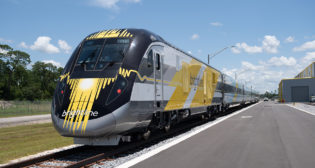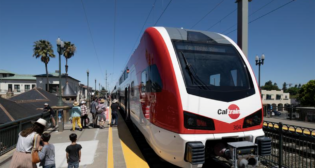
Fitch Ratings for NYMTA: TRBs “A+”; BANs “F1”; Outlook “Negative”
Written by William C. Vantuono, Editor-in-ChiefFitch Ratings has assigned a rating of “A+” to approximately $600 million of Transportation Revenue Bonds (TRB) Series 2020D (Mandatory Tender Bonds) and a rating of “F1” to $500 million of transportation revenue Series 2020B Bond Anticipation Notes (BANs) to be issued by the New York Metropolitan Transportation Authority. The bonds and BANs will be sold via negotiation; the sale date and principal amount are both subject to market conditions. Proceeds will finance existing approved transit and commuter projects. Fitch has affirmed at “A+” approximately $24.4 billion of outstanding TRBs. The Rating Outlook is Negative.
SECURITY
“The TRBs are backed by a gross lien on the MTA’s operating revenues, which include, among other sources, fares received from the subway and bus systems operated by MTA New York City Transit and its subsidiary, the Manhattan and Bronx Surface Transit Operating Authority, the commuter railroads operated by MTA Long Island Rail Road and MTA Metro-North Railroad, and buses operated by MTA Bus,” Fitch noted. “TRBs are also backed by a gross lien on operating subsidies from the state of New York, New York City, and surplus from the operation of the Triborough Bridge and Tunnel Authority (TBTA). The BANs are payable from the proceeds of other notes or TRB obligations to be issued by the MTA.”
KEY RATING DRIVERS
Fitch’s Analytical Conclusion: “The ‘A+’ rating on the TRBs reflects the benefit of statutory provisions that explicitly prevent the MTA or any of its subsidiary corporations from filing a voluntary petition for bankruptcy protection so long as the MTA has TRBs outstanding. Fitch believes this statutory framework combined with bondholders’ gross lien on TRB pledged revenues tempers risk to the MTA’s otherwise high leverage position and capital needs.
“Fitch’s public transit ratings assume a degree of higher level government support to maintain system solvency due to the strategic importance of transit to local economies and other public policy goals, including the mobility of public health and safety workers in the current [COVID-19] health crisis. Furthermore, Fitch continues to believe that the MTA benefits from greater support from its sponsoring governments than typical U.S. transit agencies and has the highest strategic and economic importance among its peer group. The TRB note rating at ‘F1’ maps to the ‘A+’ rating on the TRBs.
“The Negative Outlook reflects the ongoing fiscal pressure on the MTA following the outbreak of the coronavirus and subsequent declines in system ridership and revenue, among other challenges. Fitch believes these pressures compound the MTA’s pre-virus fiscal status, characterized by thin operating margins and large out-year budget gaps, and weaken its prospects for credit quality improvement through the end of 2021.
“The MTA has forecast a budget gap of $3.75 billion in 2020 (22% of spending) and $6.55 billion (38%) in 2021. The forecast reflects the midpoint of several utilization and revenue scenarios. For transit, ridership through the remainder of 2020 is assumed at 40% and 21% in the moderate and severe scenarios, respectively. Ridership is presently down 82% as of June 22, compared to 2019 results.
“For MTA Bridges and Tunnels (TBTA), the moderate and severe scenarios assume a 57% and 44% level of activity, respectively. For the period June 1 through June 24, [bridge] crossings were down by an estimated 32% over the prior year. Utilization remains considerably below 2019 levels, but it is improving slowly in conjunction with the phased reopening of the greater New York City-area economy. Downside risk remains, particularly if there is a re-emergence of infections and lockdown measures reoccur.
“In response to the budget crisis, the MTA has requested an additional $3.9 billion in federal grant assistance to close the 2020 budget gap. The MTA’s request was included in the Health and Economic Recovery Omnibus Emergency Solutions (HEROES) Act passed in the U.S. House of Representatives in mid-May but has not been acted on by the U.S. Senate. The prospects for additional federal support are unclear, and in the best-case scenario, the MTA would continue to face a substantial budget gap for 2021 under its midpoint scenario. The MTA expects to exhaust the $4.0 billion allocated to it under the Coronavirus Aid, Relief, and Economic Security (CARES) Act by August. The CARES funding has been used to offset the aforementioned revenue declines and to cover increased costs associated with daily system cleaning, PPE purchase, etc., estimated to reach approximately $500 million by year-end.
“Deficit borrowing and delaying the start of new capital projects are among the various cash flow conservation measures Fitch expects the MTA will take to continue to meet its financial obligations in a full and timely manner during this challenging period. Wage freezes and reductions in force are also being explored. Generally, MTA workers are not protected by ironclad layoff restrictions, and the MTA has enacted large-scale reductions in force in response to prior periods of fiscal stress. Labor spending accounts for an estimated $11.9 billion in 2020, or roughly $230 million per week (on a cash basis including benefits). Effective May 6, the MTA instituted an unprecedented [four-hour] overnight shutdown of the subway system to disinfect trains and stations, but service reductions could be expanded as part of a plan to address the current fiscal emergency.
“The MTA continues to work closely with its governmental funding partners including New York State (NYS), which has recently designated the MTA as an eligible issuer under the Federal Reserve’s Municipal Liquidity Facility (MLF) and authorized it, through 2022, to borrow up to $10 billion to fund operating costs. NYS has also temporarily allowed the MTA to tap revenues from a new graduated tax on high-value home sales and revenues associated with internet sales activity to fund operating costs. These revenues were statutorily dedicated to fund $10 billion of the MTA’s 2020-2024 capital program; an additional $15 billion is expected to be funded from a tolling program within the Manhattan central business district that has yet to receive federal approval.
“The MTA expects to offset any deficit borrowing by reducing the estimated $10 billion in TRB debt scheduled to be issued to fund the 2020-2024 capital program. The MTA has already put on hold the execution of contracts related to the 2020-2024 capital program, although certain previous commitments for existing work associated with the 2015-2019 plan are being accelerated, given current low ridership conditions. Near-term cash flow benefits associated with reductions in service and/or planned capital investment face countervailing risks to system performance failures and prolonged ridership recovery, which could lead to negative rating pressure in the intermediate term.
“Liquidity to cover immediate obligations remains adequate for now. As of June 25, the MTA reported $5.6 billion in liquidity to cover its operating costs, including $2.3 billion of cash, $1.8 billion of undrawn or unspent commercial bank lines of credit (the MTA is authorized to solicit up to an additional $1 billion in bank facilities, pending market conditions), $1.2 billion of internal available flexible funds, and $330 million in OPEB reserves. Fitch estimates the MTA’s cash burn-rate at approximately $300 million per month. The reported cash position is net of amounts set aside to fund the upcoming November TRB debt service payments.
“Revenue Defensibility: Stronger. The strategic importance of the MTA transit system, bridges and tunnels to the economy of the New York region is the cornerstone of the ‘stronger’ revenue defensibility assessment. It supports an expectation for ongoing financial support from the state and the city, including periodic authorization of new recurring revenue sources, to fund the MTA’s operating and capital budget.
“Operating Risk: Midrange. The MTA’s operating profile is driven by its cost of labor, including fringe benefits for existing and retired employees, and the financing of its extensive capital program. The MTA has been the beneficiary of new funding sources for both its operating and capital plan in recent history, but thus far it has failed to achieve meaningful labor reforms that Fitch considers critical to eliminating out-year budget imbalances. The MTA has consistently produced near-term solutions to its budgetary challenges in the past via a combination of fare increases, cost saving programs and non-recurring measures.
“Financial Profile: Stronger. The MTA’s ability to maintain financial leverage metrics consistent with its operating risk profile is an important long-term rating consideration. Fitch expects the MTA will adjust the implementation of non-essential capital investment in response to its current liquidity crisis, which may have adverse consequences on system performance and ridership over the intermediate term. Leverage pressures may materialize from financial market instability resulting in increases in the MTA’s net pension liabilities, or the incurrence of additional long-term debt to replace programmed pay-as-you-go capital, given its decline in revenue and near-term liquidity risk.
“Fitch’s leverage analysis focuses on pledged gross TRB revenues rather than cash flow available for debt service. This alternative view of financial leverage is based on the protection afforded to bondholders from the gross lien on pledged TRB revenues, statutory provisions that restrict the MTA from filing for bankruptcy protection, and a covenant of New York State not to change the law to permit the MTA to file such a petition as long as any TRBs are outstanding.
“ESG Considerations: The MTA has an ESG (Environmental, Social and Governance) Relevance Score of ‘4’ for Labor Relations and Practices due to the challenging labor environment in which it operates and its high cost of labor including fringe benefits for existing and retired employees, which has a negative impact on the credit profile and is relevant to the rating in conjunction with other factors.”



